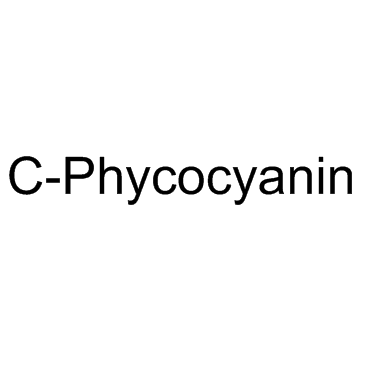C-Phycocyanin

C-Phycocyanin structure
|
Common Name | C-Phycocyanin | ||
|---|---|---|---|---|
| CAS Number | 11016-15-2 | Molecular Weight | N/A | |
| Density | N/A | Boiling Point | N/A | |
| Molecular Formula | N/A | Melting Point | N/A | |
| MSDS | USA | Flash Point | N/A | |
| Symbol |


GHS06, GHS09 |
Signal Word | Danger | |
Use of C-PhycocyaninC-phycocyanin is a water-soluble protein pigment which is also widely used as an excellent nutrient supplement for human beings. |
| Name | Phycocyanin |
|---|---|
| Synonym | More Synonyms |
| Description | C-phycocyanin is a water-soluble protein pigment which is also widely used as an excellent nutrient supplement for human beings. |
|---|---|
| Related Catalog | |
| In Vitro | For the combination experiments, when cells treated with All-trans retinoic acid (ATRA) combined with C-phycocyanin, the IC50 value is lower than that in ATRA group. But under the same IC50, the more C-phycocyanin is used, the less ATRA is needed. Results demonstrate that C-phycocyanin combined with ATRA can significantly decrease CDK-4 mRNA level (P<0.05). The combination index (CI) value of the C-phycocyanin+ATRA combination group is 0.852 which is less than 1, indicating that the two drugs are synergetic under the action concentration (88 μg/L C-phycocyanin+0.102 mM ATRA). Compare with control group, the Integrated optical density (IOD) in C-phycocyanin or ATRA treated group is increased, and the differences are statistically significant (P<0.05) and the differences are further exaggerated in combination group (P<0.01). The expression of caspase-3 in C-phycocyanin group is more than that in the control group but is similar to that in ATRA group, whereas the expression in combination group is maximum[1]. |
| In Vivo | Compare with control group, the average tumor weights of mice in solely C-phycocyanin or ATRA treatment groups are significantly decreased, and further reduced in C-phycocyanin+ATRA synergy group. Results show that single C-phycocyanin can increase the spleen weight of mice but the effects of ATRA are just opposite. C-phycocyanin can also promote the growth of immune organs in mice and increase the body's immune function. C-phycocyanin and ATRA alone can significantly inhibit Cyclin D1 expression, and when being combined, the inhibitory effect is more obvious[1]. |
| Cell Assay | A549 cells are divided into four groups: (1) control group: the cells are not treated with any drug. (2) C-phycocyanin (C-PC) treated group: the cells are treated with C-phycocyanin alone. (3) All-trans retinoic acid (ATRA) treated group: the cells were treated with ATRA alone. (4) C-phycocyanin+ATRA combined group: the cells are treated simultaneously with C-phycocyanin and ATRA. For the combined treatment group, the combination index (CI) between two drugs is calculated. CI values of less than, equal to, and more than 1 indicate synergy, additivity, and antagonism, respectively[1]. |
| Animal Admin | A total of 40 adult NU/NU mice (20 males and 20 females, 20 to 22 g) are used for the study. The mouse tumor models are set up by subcutaneous injection of 2×106 A549 cells near the armpit area. Fifteen days later, the mice are randomly divided into four groups: control group, All-trans retinoic acid (ATRA) treatment group which is treated with 0.2 mL ATRA (10 mM), C-phycocyanin treatment group which is given 0.2 mL C-phycocyanin (320 mg/mL), and C-phycocyanin+ATRA treatment group receiving 0.2 mL C-phycocyanin (320 mg/mL) and 0.2 mL ATRA (10 mM) at the same time. These agents are injected into the area of tumors and the duration of drug treatment is 10 days. Two days after drug withdrawal, the mice are executed, and then tumors and spleens are picked out[1]. |
| References |
| Storage condition | 2-8°C |
|---|
| Symbol |


GHS06, GHS09 |
|---|---|
| Signal Word | Danger |
| Hazard Statements | H301 + H311-H411 |
| Supplemental HS | Contact with acids liberates very toxic gas. |
| Precautionary Statements | P273-P280-P301 + P310 + P330-P302 + P352 + P312-P391-P501 |
| Hazard Codes | T+ |
| Risk Phrases | 24/25-51/53 |
| Safety Phrases | 36/37-45-61 |
| RIDADR | 1687.0 |
|
Investigation on the role of Spirulina platensis in ameliorating behavioural changes, thyroid dysfunction and oxidative stress in offspring of pregnant rats exposed to fluoride.
Food Chem. 140(1-2) , 321-31, (2013) The study investigated the role of Spirulina platensis in reversing sodium fluoride-induced thyroid, neurodevelopment and oxidative alterations in offspring of pregnant rats. The total antioxidant act... |
|
|
Structure of the cyanobacterial phytochrome 2 photosensor implies a tryptophan switch for phytochrome signaling.
J. Biol. Chem. 288(50) , 35714-25, (2013) Phytochromes are highly versatile photoreceptors, which occur ubiquitously in plants as well as in many light-responsive microorganisms. Here, photosynthetic cyanobacteria utilize up to three differen... |
|
|
DA virus mutant H101 has altered CNS pathogenesis and causes immunosuppression.
J. Neuroimmunol. 277(1-2) , 118-26, (2014) Viruses use various mechanisms to evade clearance by the host. Investigating how a few changes in the genome of a non-lethal virus can lead to altered disease, from survivable to immunosuppression/dea... |
| Phycobilisome protein |
| C-Phycocyanin |
| Phycocyanins, C- |